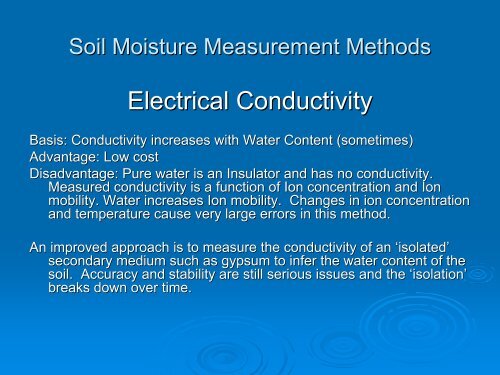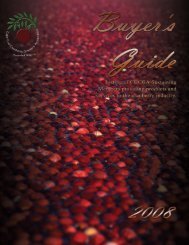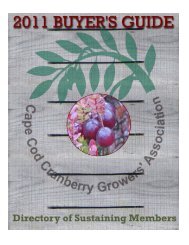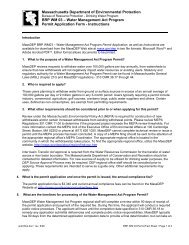Soil Moisture Measurement Methods Neutron Probe
Soil Moisture Measurement Methods Neutron Probe
Soil Moisture Measurement Methods Neutron Probe
Create successful ePaper yourself
Turn your PDF publications into a flip-book with our unique Google optimized e-Paper software.
<strong>Soil</strong> <strong>Moisture</strong> <strong>Measurement</strong> <strong>Methods</strong><br />
Electrical Conductivity<br />
Basis: Conductivity increases with Water Content (sometimes)<br />
Advantage: Low cost<br />
Disadvantage: Pure water is an Insulator and has no conductivity.<br />
Measured conductivity is a function of Ion concentration and Ion<br />
mobility. Water increases Ion mobility. Changes in ion concentration<br />
and temperature cause very large errors in this method.<br />
An improved approach is to measure the conductivity of an ‘isolated’<br />
secondary medium such as gypsum to infer the water content of the<br />
soil. Accuracy and stability are still serious issues and the ‘isolation’<br />
breaks down over time.
<strong>Soil</strong> <strong>Moisture</strong> <strong>Measurement</strong> <strong>Methods</strong><br />
<strong>Neutron</strong> <strong>Probe</strong><br />
Basis: Emitted <strong>Neutron</strong>s from isotope source lose energy only as they impact<br />
hydrogen atoms (water). <strong>Neutron</strong> detector response weakens as soil water<br />
content increases.<br />
Advantages: Insensitive to temperature, soil EC, compaction, etc. Only<br />
responsive to soil water content (or other hydrogen-bearing constituents). Very<br />
large sampling volume.<br />
Disadvantages: Very high cost. Requires license to operate. Cannot be<br />
installed permanently. Must be calibrated to the source of neutrons.
<strong>Soil</strong> <strong>Moisture</strong> <strong>Measurement</strong><br />
<strong>Methods</strong><br />
Specific Heat: ΔT T ~ k(ΔJ)<br />
Basis: Water has higher specific heat than soil minerals<br />
Advantage: Insensitive to EC<br />
Disadvantages: <strong>Measurement</strong> Sample Boundary,<br />
<strong>Measurement</strong> Sample Size, Power Consumption, Specific<br />
Heat Differentiation
<strong>Soil</strong> <strong>Moisture</strong> <strong>Measurement</strong> <strong>Methods</strong><br />
Tensiometer<br />
Basis: Water concentration comes to equilibrium across a semi-permeable<br />
membrane.<br />
Advantage: Immune to soil EC<br />
Disadvantages: Frequent Maintenance, Vacuum break vulnerability
<strong>Soil</strong> <strong>Moisture</strong> <strong>Measurement</strong> <strong>Methods</strong><br />
Permittivity <strong>Measurement</strong> – Capacitor<br />
Basis: Dielectric constant of water is ~30X that of other soil constituents.<br />
c<br />
Advantage: low cost<br />
Disadvantages: EC losses in the soil confound the capacitance readings.<br />
Dielectric constant of water is temperature dependent. Capacitive e probes<br />
are ‘surface’ sensitive and thus subject to large air-gap errors.<br />
Compensation is very difficult due to the requirement to separate<br />
temperature and EC errors.
<strong>Soil</strong> <strong>Moisture</strong> <strong>Measurement</strong> <strong>Methods</strong><br />
Permittivity <strong>Measurement</strong> – LC<br />
Resonance<br />
ω = 1/LC<br />
Basis: Same as Capacitor method.<br />
Advantage: Some configurations allow tube measurements at various<br />
depths. Higher frequency operation results in EM wave penetration<br />
of the soil, reducing air gap problem.<br />
Disadvantages: High cost for tube insertion types. Sensitive to soil EC.<br />
Sensitive to <strong>Soil</strong> Temperature. Sensitive to air gap between plates<br />
and soil. Sensitive to Compaction. Separation of error-causing errors<br />
is very difficult.
<strong>Soil</strong> <strong>Moisture</strong> <strong>Measurement</strong> <strong>Methods</strong><br />
EM Wave Propagation Time – Analog TDR<br />
c =<br />
1<br />
με<br />
Basis: Speed of light is inversely proportional to sq rt of permittivity. <strong>Soil</strong><br />
permittivity is dominated by water content.<br />
Advantage: High Accuracy. Large sampling volume. Well-understood standard<br />
for permittivity measurement.<br />
Disadvantages: Very high cost. Waveform distortion errors from soil EC.
<strong>Soil</strong> <strong>Moisture</strong> <strong>Measurement</strong> <strong>Methods</strong><br />
EM Wave Propagation Time – Analog FDR<br />
Basis: Speed of light is inversely proportional to sq rt of permittivity. <strong>Soil</strong><br />
permittivity is dominated by water content. Frequency of fixed-length<br />
standing wave oscillation is dominated by water content.<br />
Advantage: Large sampling volume. Lower cost than Analog TDR.<br />
Disadvantages: Sensitive to <strong>Soil</strong> EC and compaction. More difficult to interpret<br />
than Analog TDR.
<strong>Soil</strong> <strong>Moisture</strong> <strong>Measurement</strong> <strong>Methods</strong><br />
EM Wave Propagation Time – Analog TDT<br />
Basis: Same as Analog TDR<br />
Advantage: Higher Signal to Noise Ratio than TDR.<br />
Disadvantages: EC distortion of waveform causes large permittivity ty reading<br />
errors. Requires Excavation for Installation.
<strong>Soil</strong> <strong>Moisture</strong> <strong>Measurement</strong> <strong>Methods</strong><br />
EM Waveform Propagation Time – Digital TDT<br />
Basis: Same as Analog TDR<br />
Advantages: Stability far exceeds all other sensors – the<br />
stability standard for the industry. Lower cost than<br />
analog TDR. Low sensitivity to compaction. Deep<br />
waveform penetration provides High Sampling Volume<br />
and low air gap sensitivity. GHz operation reduces<br />
complex permittivity errors in clay soils. Linear. Highest<br />
Durability. Very Easy to Use.<br />
Disadvantage: Excavation needed for Installation.
Absolute vs. Relative<br />
Absolute:<br />
The sensor provides a stable moisture reading when soil<br />
type, compaction, EC or temperature changes. The<br />
sensor is unresponsive to these variables over wide<br />
ranges.<br />
Relative:<br />
The sensor reading increases and decreases with<br />
moisture content but also changes with EC, temperature,<br />
compaction, soil type, etc. Attempts to separate the<br />
effects of these variables from the output signal are<br />
deceptive. Relative sensors are unstable. . They require<br />
calibration to the specific installation environment. As the<br />
environment changes the readings become unreliable.
Calibration of Relative Sensors<br />
Relative Sensors require calibration so that their readings can be<br />
correlated to absolute soil moisture or hydrostatic pressure. This T<br />
calibration compensates for the specific EC, temperature, complex<br />
permittivity (soil type) and compaction of the soil around the sensor. s<br />
In some cases different models of sensors are sold that are factory<br />
calibrated for a near match to different soil conditions.<br />
Neither approach works. <strong>Soil</strong> conditions change.<br />
Ask for independent verification of manufacturers<br />
claims before buying sensors.
<strong>Soil</strong> <strong>Moisture</strong> <strong>Measurement</strong> <strong>Methods</strong><br />
Sensor<br />
Type<br />
Digital TDT<br />
Cost<br />
Medium/Low<br />
(8)<br />
Stability<br />
Sampling<br />
Volume<br />
Durability<br />
Excellent (10) Good (9) Exc. (10)<br />
Ease of<br />
Use<br />
Good<br />
(10)<br />
Analog FDR High (2) Good (8) Good (6) Exc. (10) Good (8) 34<br />
Analog TDT<br />
Medium/Low<br />
(8)<br />
Score<br />
Good (6) Fair (3) Good (5) Good (8) 30<br />
Analog TDR Very High (-2)(<br />
Good (8) Good (9) Exc. (10) Poor (2) 27<br />
Capacitance Low (9) Poor (1) Poor (2) Good (5) Good (7) 23<br />
47<br />
Tensiometer Medium (7) Good (6) Good (6) Poor (1)<br />
Poor (2)<br />
22<br />
Gypsum<br />
Block<br />
<strong>Neutron</strong><br />
<strong>Probe</strong><br />
Specific Heat<br />
LC<br />
Resonance<br />
Low (10) Fair (2) Fair (2) Poor (0) Good (7) 21<br />
Very High (-5)(<br />
Excellent (10) Exc. (10) Fair (3) Poor (1) 19<br />
Medium/High<br />
(6)<br />
Fair (5) Poor (-5)(<br />
Fair (2)<br />
High (1) Poor (1) Fair (7) Fair (3)<br />
Conductivity Low (9) Very Poor (-(<br />
20)<br />
Good (8) Fair (2)<br />
Good (6)<br />
Poor (1)<br />
Poor (1)<br />
14<br />
13<br />
0
Closed-Loop Irrigation Concepts<br />
-The Future of Irrigation<br />
In Consideration of:<br />
Cost<br />
Stability<br />
Durability<br />
Ease of Use<br />
Maintenance
The Limits of Effective Irrigation<br />
Saturation:<br />
Waste<br />
Control Range<br />
3 to 8 percentage points WVC<br />
Stress<br />
Death<br />
Gravitational Water:<br />
-Heavy Nutrient and Water Loss<br />
-Root Putrefaction<br />
Field Capacity:<br />
Plant Available Water<br />
50% PAW Depletion Limit<br />
Permanent Wilt Point:
Available Water Capacity
‣ About Groundwater and the Water Cycle<br />
‣ Groundwater is an integral part of the earth's water cycle.<br />
‣ The water (or hydrological) cycle is the continuous, repeating journey j<br />
of water<br />
between the earth and the atmosphere. Heating of the ocean water by the sun<br />
keeps the cycle in motion. After water evaporates, it condenses to form clouds,<br />
then falls to the earth as precipitation (rain, snow, sleet, and hail).<br />
‣ Some of the water evaporates again, some stays on the surface, becoming b<br />
streams, rivers, lakes, etc., while a certain amount soaks, or infiltrates, i<br />
into the<br />
ground, becoming groundwater.<br />
‣<br />
‣ The water moves downward through empty spaces or cracks in the soil, s<br />
sand, or<br />
rocks until it reaches a layer of rock through which water cannot t easily move.<br />
The water then fills the empty spaces and cracks above that layer, much like<br />
filling a bathtub. The top of this stored water, or aquifer, is called the water table<br />
and the water that fills the empty spaces and cracks is called ground g<br />
water. The<br />
water table may be only a foot below the ground's surface or it may be hundreds<br />
of feet down.<br />
‣ The world has a limited amount of water, and if not for this cycle, we would not<br />
have this continuous source of water to recharge our aquifers.<br />
‣ Groundwater is used for drinking water, agriculture, commercial and industrial<br />
needs. Over time, groundwater also discharges to lakes, wetlands, , streams,<br />
rivers, and the ocean. It helps keep streams cool and flowing during the hot, dry<br />
seasons; this is critical to wildlife habitat, especially for salmon.
Closed-Loop Irrigation<br />
An Automatic Feedback Control System<br />
Control Range<br />
Parameters<br />
Σ<br />
Irrigation<br />
Scheduler<br />
& Delivery<br />
Means<br />
Root<br />
Zone<br />
Stable <strong>Soil</strong><br />
<strong>Moisture</strong> Sensor
Basic System Requirement for<br />
Closed-Loop Control<br />
A Stable Sensor vs. <strong>Soil</strong> EC, Temperature and Time<br />
∂<br />
E∂ ∂<br />
The System’s Ability to Maintain <strong>Moisture</strong> within Control<br />
Range is Limited by the Stability of the Sensor.<br />
Unstable Sensor = Stressed Turf & Wasted Water<br />
Stable Sensor = 100% Irrigation Adequacy and Efficiency
Sensing Technologies<br />
‣ Direct Conductivity (snake oil)<br />
‣ Indirect Conductivity* (response, mortality)<br />
‣ Direct Capacitance* (EC losses, surface sensitivity)<br />
‣ Indirect LC Capacitance (EC losses, surface sensitivity)<br />
‣ Specific Heat* (power, sampling volume)<br />
‣ Tensiometer (maintenance, range, durability)<br />
‣ Analog Time Domain Reflectometer (EC distortion, reflection loss)<br />
‣ Analog Time Domain Transmissometer* (EC distortion)<br />
‣ Wide Band Frequency Domain Reflectometer (EC absorption)<br />
‣ <strong>Neutron</strong> <strong>Probe</strong> (regulations, cost, calibration)<br />
‣ Digital TDR (cost, reflection loss, bulk, intimidation)<br />
‣ Acclima Digital TDR* (reflection loss)<br />
‣ Acclima Digital TDT* (excavation disruption)<br />
*Sensors with which Acclima has development experience.
Technology Grouping<br />
‣ Conductivity<br />
‣ Capacitance <strong>Measurement</strong><br />
‣ Specific Heat<br />
‣ Vacuum Tension<br />
‣ Analog Propagation Time<br />
‣ Nuclear Ballistic<br />
‣ Digital Propagation Time
Digital TDT/TDR Technology<br />
‣ Water Content is Derived from the Details<br />
of a Propagated EM Wave<br />
‣ High Resolution, Low Cost Digital<br />
Waveform Analysis (patented)<br />
• 12-bit A/D conversion with 5ps resolution (.06%VWC)<br />
• 200 GS/sec equivalent A/D conversion rate<br />
• Industry’s s Highest Performance <strong>Moisture</strong> Sensing<br />
Circuitry has ~$6 materials cost incl. uP.<br />
• Inert, Indestructible Materials<br />
‣ Demo
Temperature Stability<br />
Clay <strong>Soil</strong> – Frozen and Sealed with Embedded Sensor<br />
37<br />
Melting Ice Crystals<br />
35<br />
33<br />
VWC (%)<br />
31<br />
29<br />
27<br />
25<br />
0<br />
3<br />
6<br />
9<br />
12<br />
15<br />
18<br />
21<br />
24<br />
27<br />
30<br />
33<br />
36<br />
39<br />
42<br />
45<br />
48<br />
51<br />
54<br />
Temperature C
EC Stability<br />
EC Stability<br />
Measured in Distilled Water with Incrementally Added NaCl<br />
105<br />
100<br />
95<br />
90<br />
VWC (%)<br />
85<br />
80<br />
75<br />
0.023<br />
0.261<br />
0.604<br />
1.108<br />
1.333<br />
1.622<br />
1.76<br />
2.52<br />
2.92<br />
3.43<br />
4.3<br />
5.54<br />
7.04<br />
8.77<br />
10.11<br />
EC (dS/m)
Acclima Sensor Family<br />
‣ Digital TDT with 2-wire 2 wire Interface<br />
• Operates on 24VAC using existing wiring<br />
• No need to install wiring to the controller<br />
• Includes single-zone valve switch<br />
‣ Digital TDT with SDI-12 Interface<br />
• Designed for battery operation<br />
• Communicates over RS-232<br />
232-like protocol<br />
• Easily modified to wireless operation<br />
‣ Digital TDR (prototype)
Market Implications<br />
‣ Highest Performance SWAT:<br />
• Strong Approval from Regulators & Purveyors<br />
• Promotional Assistance from Researchers<br />
‣ Automatic Parameter Setup (AAII)<br />
• Declining User Learning Curve<br />
• Easily Recoverable Operating Parameters<br />
‣ Low Cost<br />
• Universally Affordable – Easily Rebated<br />
• Single Season Payback
Closed-Loop Advantages<br />
‣ In-Root<br />
Root-Zone <strong>Measurement</strong> & Control<br />
‣ <strong>Measurement</strong> (not Inference) of Controlled<br />
Variable – SM Level Relative to Control<br />
Range<br />
‣ Immediate and Continuous Knowledge of<br />
Static <strong>Moisture</strong> Level<br />
‣ Calculable Site-Specific Specific Parameters for<br />
Automatic Setup and Optimum Irrigation<br />
Control
Relative to ET Systems…<br />
‣ Lower Cost<br />
‣ Higher Watering Efficiency<br />
‣ No Maintenance<br />
‣ Physics-Based Automatic Setup










